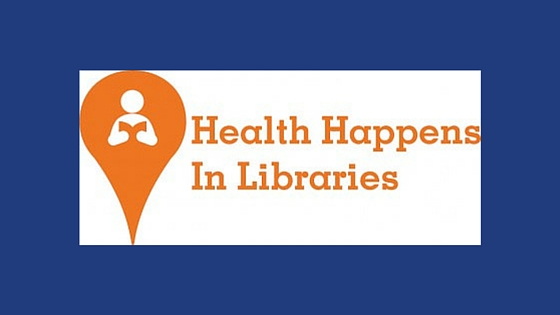Health Happens in Libraries Part I: Public Libraries Promote Health Literacy

Just as public libraries are about more than books, health is about more than healthcare. Partnerships between public libraries and community health stakeholders address disparities in access to health information and services by providing inclusive entry points to reliable and relevant health resources and support. Access to and meaningful use of information is core to effective individual health management. Experts recognize that health literacy is essential for individuals, organizations, and communities to develop.[1] Yet in the United States, adult health literacy levels vary from below basic (14 percent), to basic (22 percent), intermediate (53 percent) and proficient (12 percent).[2] Title V of the Affordable Care Act defines health literacy as “the degree to which an individual has the capacity to obtain, communicate, process, and understand health information and services in order to make appropriate health decisions.”[3]
Recognizing this gap in sufficient health literacy, organizations from multiple sectors (including the Institute of Medicine, Public Library Association, and Red Cross) have contributed to the National Action Plan to Improve Health Literacy. The plan emphasizes the importance of cross-sector collaboration and authentic community engagement, particularly to “support and expand local efforts to provide adult education, English language instruction, and culturally and linguistically appropriate health information services in the community.”[4]
Public libraries are trusted community institutions that provide the information literacy expertise, community convening capacity, technology infrastructure, and equitable access to reliable resources that can improve health literacy. And community demand for these services is strong.
The Opportunity for All report notes that in 2009, an estimated 28 million people used public library computers for health and wellness purposes, such as learning about a disease, medical condition or illness, learning about diet and nutrition, or learning about a medical procedure. Patrons also reported using library computers to find doctors, identify support groups, and connect with healthcare providers.[5]
According to the results of the 2014 Digital Inclusion Survey, public libraries in the United States advance equal access to health information in many ways.
o 59.4 percent of libraries help patrons identify health insurance resources;
o 57.7 percent help patrons locate and evaluate free health information online;
o 48.1 percent help patrons understand specific health or wellness topics;
o 22.7 percent offer fitness classes; and
o 18.1 percent bring in healthcare providers to offer limited healthcare screening services [6]
This help occurs in many forms, such as informal point of use assistance, training from a library staff member or volunteer, or programming with local partner organizations. Margot Malachowski, Outreach Librarian with Baystate Health in Massachusetts, describes ways in which public libraries contribute to the “patient activation” process by providing skilled referral to physical, digital, and community-based resources.[7] By framing these contributions in the context of health literacy as well as the federal Healthy People 2020 initiative for public health improvement, it is clear that public libraries are an asset to the consumer health information ecosystem.
OCLC’s Health Happens in Libraries program was designed to magnify the role of public libraries as key contributors to community health. The program team recently produced a free, downloadable infographic for public libraries to use in conversation with patrons and other community collaborators about the many dynamic ways public libraries build healthy communities.
In the second article of this three-part series, we will share a brief overview of the evolution of this program and the resources developed for public library staff to take action on community health priorities. Part III will feature key learning from community health engagement efforts with five public libraries.
Erin Schadt and Kendra Morgan contributed to this article.
Note: This article is an extension of a poster presentation from OCLC and program partners from ZeroDivide at the American Library Association annual conference in June 2015 titled “Health Happens in Libraries through Community Engagement.” Comprehensive program resources can be accessed at http://oc.lc/ehealth.
Resources
National Action Plan to Improve Health Literacy (PDF), U.S. Department of Health and Human Services
2014 Digital Inclusion Survey: Survey Findings and Results
Health Happens in Libraries infographic
References
[1] L.W. Jackman, “Health Literacy: A National Responsibility—Our Brothers’ Keeper,” College & Undergraduate Libraries 20, no. 1 (2013): 95–106, doi: 10.1080/10691316.2013.761028.
[2] Mark Kutner, et. al., The Health Literacy of America’s Adults: Results From the 2003 National Assessment of Adult Literacy, (Washington, D.C.: U.S. Department of Education, National Center for Education Statistics, 2006): 483.
[3] “Title V: Health Care Workforce,” Affordable Care Act (U.S. Department of Health and Human Services, 2015): 1,252.
[4] National Action Plan to Improve Health Literacy (Washington, D.C.: United States Department of Health and Human Services Office of Disease Prevention and Health, 2010): 2.
[5] Samantha Becker, et. al., Opportunity for All: How the American Public Benefits from Internet Access at U.S. Libraries (Washington, D.C.: Institute of Museum and Library Services, IMLS-2010-RES-01).
[6] John Carlo Bertot, et. al., 2014 Digital Inclusion Survey: Findings and Results (College Park, MD: Information Policy & Access Center, University of Maryland College Park, 2015).
[7] Margot Malachowski, “Patient activation: Public libraries and health literacy,” Computers in Libraries 31, no. 10 (2011): 5.
Tags: affordable care act, Digital Inclusion Survey, health information at the library, health literacy, oclc












